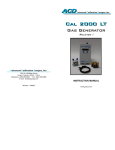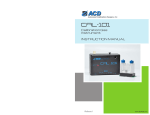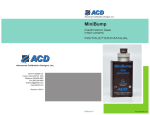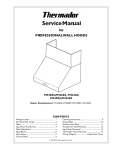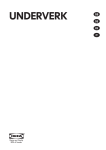Download Best Power B510-0600A Instruction manual
Transcript
ACD Advanced Calibration Designs, Inc. EC Cal Gas Generator Release III MANUFACTURED BY: Advanced Calibration Designs, Inc. 1775 S. Pantano Road, Suite 140 Tucson, Arizona 85710 U.S.A. Telephone: (520) 290-2855 Fax: (520) 290-2860 Web Site: www.GoACD.com E-mail: [email protected] Revision - 070101 INSTRUCTION MANUAL www.goacd.com WARNING: This instrument generates calibration gas for toxic gas detectors. The instruction manual should be read and understood prior to operation of the instrument. Failure to operate the instrument correctly can lead to improper calibrations. This instrument conforms to the protection requirements of the EC DIRECTIVE 89/336/ EEC on Electromagnetic Compatibility (EMC), in accordance with the provisions of Statutory Instrument 2372. The following standards have been applied: EN 50081-1 Emissions Standard (Residential Commercial and Light Industry) EN 50082-1 Immunity Standard (Residential Commercial and Light Industry) NOTES: TABLE OF CONTENTS I. General Description Page 2 II. Normal Operation, Diffusion Mode Page 5 III. Normal Operation, Sample Draw Mode Page 8 IV. Menu Options Page 9 V. LCD Warning Displays Page 10 VI. Accessory Items / Parts List Page 11 VII. Warranty Information Page 12 Page 14 NOTES: I. GENERAL DESCRIPTION The EC Cal is a small battery-powered, portable electrochemical gas generator designed to calibrate toxic gas sensors. Fast warm-up time allows the instrument to be turned off between remotely located sensors saving battery life and avoiding generation of unwanted gas. A built-in mass flow sensor provides accurate flow control and the ability to measure externally provided sample draw flow rates. The EC Cal uses the following components to produce the calibration gas/air mixture: Internal Micro Pump A small, rotary vane, micro air pump draws in ambient air to blend with the generated gas. The pump may be disabled for use in calibrating sample draw instruments. Electrochemical Generating Cell The electrochemical generating cell contains an electrolyte solution and either inert or consumable electrodes, depending upon the gas being generated. A precise concentration of gas is produced when a known amount of current and a known amount of air is supplied continuously to the cell. Each cell has a builtin memory chip that tells the EC Cal what type and range of gas can be generated and how much cell life is remaining. Alkaline "AA" Batteries A set of four fully charged, heavy duty alkaline "AA" batteries provides 10-12 hours of operation. To replace the batteries, open the battery cover with either a fingernail or small flat object. Note: Rechargeable or light duty batteries give significantly less operating time. SAFETY NOTE: Do not use any metallic item such as a screwdriver to remove the batteries from the instrument. This can short the instrument’s fuse rendering the unit inoperable. Microprocessor-Based Circuitry Page 13 The EC Cal has microproccessor based circuitry that performs several different operations and offers the user many different features. The microprocessor tracks cell and battery usage, monitors the air flow rate and controls the cell and pump to give the selected ppm and flow rate. The main circuit board plugs directly to the power board which is soldered to the battery terminals. The pump, manifold board and manifold are attached to the main board and lift out of the bottom case as one unit. Four pan head phillips screws hold the main board firmly to the lower case. Page 2 Digital Display VII. The EC Cal has a liquid crystal display (LCD) located on the front of the instrument. This display is protected by a thin, clear plastic cover that is part of the front label and may be replaced if it becomes scratched or unclear. We warrant gas calibration equipment manufactured and sold by us to be free from defects in materials, workmanship and performance for a period of one year from date of shipment. Any parts found defective within that period will be repaired or replaced, at our option, free of charge, F.O.B. factory. This warranty does not apply to those items which by their nature are subject to deterioration or consumption in normal service, and which must be cleaned, repaired, or replaced on a routine basis. POWER and SELECT The POWER and SELECT switches are momentary push button type switches activated through the front membrane panel. They are physical switches mounted directly on the circuit board. If the membrane area gets damaged, it is replaced as part of the entire front label. If either switch becomes nonfunctional, it must be repaired or replaced as part of the main circuit board. Such items may include, but are not limited to: Delivery Hose The instrument comes standard with a three (3) foot long, 1/4 inch diameter polyurethane hose for delivering the gas to the sensor or calibration adapter. The hose has a male quick connect adapter for easy attachment to the instrument. Standard Warranty a. Electrochemical type generating cells b. Batteries Warranty is voided by abuse including rough handling, mechanical damage, alteration, or repair procedures not in accordance with the instruction manual. This warranty indicates the full extent of our liability, and we are not responsible for removal or replacement cost, local repair costs, transportation costs or contingent expenses incurred without our prior approval. Mass Flow Sensor The EC Cal has a built-in mass flow sensor that measures the flow rate of the instrument. This information is used in two ways. With the pump engaged, it is used to control the pump to the desired flow rate over a range of 0.2 to 1.0 LPM. With the pump disabled, it is used to measure the air flow rate drawn through the EC Cal by an external pump. This information is used to adjust the cell current to the desired ppm. The flow meter should be calibrated against a primary mass flow standard every 12 to 24 months. Nylon Carrying Case A nylon carrying case is supplied with each instrument. The cases have a shoulder strap for hands free calibration and a hinged back for desk top use. Inlet Ports The EC Cal has two inlet ports located on the top of the instrument by the cell compartment. The port in the middle of the manifold is the internal pump inlet port. When the pump is turned on, air is drawn through this port, pumped though the flowmeter and cell and out the hose. The port near the edge of the manifold is used when the pump is disabled and an external pump is attached to the instrument. The sealed fitting should be removed during this operation and replaced immediately thereafter. NOTE: The instrument will not work properly with the pump on if this fitting is missing. Page 3 Advanced Calibration Designs, Inc.'s obligation under this warranty shall be limited to repairing or replacing, and returning any product which shall be returned to Advanced Calibration Designs, Inc. at its manufacturing facilities, with transportation charges prepaid, and which Advanced Calibration Designs, Inc.'s Material Review Board examination shall disclose to its satisfaction to have been defective. This warranty is expressed in lieu of any and all other warranties and representations, expressed or implied, and all other obligations or liabilities on the part of Advanced Calibration Designs, Inc. including, but not limited to, the warranty of fitness for a particular purpose. In no event shall Advanced Calibration Designs, Inc. be liable for direct, incidental or consequential loss or damage of any kind connected with the use of its products or failure of its products to function or operate properly. The following is a listing of the available electrochemical EC Cal cells and their standard prorated warranty when installed in equipment manufactured and supplied by Advanced Calibration Designs, Inc. 1. 2. 3. 4. Chlorine - One year, 50 hours of use. Hydrogen Sulfide - One year, 50 hours of use. Hydrogen Cyanide - One year, 50 hours of use. Hydrogen - One year, 50 hours of use. Page 12 VI. Accessory Items The following items are available as accessories for the EC Cal: Optional items available for the EC Cal include: External Charcaol Filter An external charcoal filter may be used to scrub contaminated air and provide a clean baseline for “zeroing” sensors. P/N Description 113-0400-00 Outlet Fitting, Body, Quick Connect, 1/8 NPT 113-0402-00 Male Hose Barb Quick Connector, 1/4" OD hose 115-0600-00 Screwcap, with Hose Fitting 150-4121-00 External Charcoal Filter Element, one each 150-4131-00 External Charcoal Filter Element, package of 12 250-0603-00 Battery Cover, EC Cal 362-0600-00 AC Adapter, 115 VAC, US style plug 6VDC, 350 mA 375-0400-00 Pump, low flow rotary vane, 6 VDC 400-0600-00 Main circuit board 400-0700-00 Power circuit board 400-0800-00 Manifold and cell circuit board 510-0600-00 Chlorine generating cell, 0.5 - 30 ppm 510-0650-00 Hydrogen sulfide generating cell, 0.5 - 30 ppm 510-0670-00 Hydrogen cyanide generating cell, 1.0 - 60 ppm 510-0690-00 Hydrogen generating cell, 0.5 - 30 ppm 700-0600-03 Low Flow pump, 6 VDC, with circuit board 715-0403-00 3 Foot Hose w/connector, low flow, 1/4" OD 715-0405-00 5 Foot Hose w/connector, low flow, 1/4" OD 730-0600-00 Nylon Carrying Case 730-0615-00 Hard-body, Water Resistant, Padded Carrying Case 910-0600-00 Instruction Manual AC Adapter The EC Cal may also be operated from an AC adapter. The AC adapter converts the AC voltage supplied from the main power lines to 6 VDC which is used in lieu of the batteries. The adapter plugs into the instrument from the bottom of the case directly into the power board and is independent of polarity. Contact the factory for exact specifications of the AC adapter. Padded Instrument Case Page 11 A water resistant, padded instrument case is available for storage and shipping of the EC Cal. The case is made out of rugged, high impact resistant plastic and will help protect the instrument in harsh environments. The foam insert may be customized to hold additional items like spare batteries and cells. Extension Hoses A longer sample hose of 5 feet may be purchased for use with the EC Cal. Page 4 II. Normal Operation, Diffusion Mode To start the generator, press and hold the POWER switch, located in the middle left front of the instrument, until the display reads A. C. D., approximately three (3) seconds. Release the switch immediately thereafter. V. LCD Warning Displays The following warning displays will appear if abnormal operation is detected by the microprocessor: "Flow too low" / Flow too high" accompanied by an audible beep. The instrument will sequence through several screens as follows: A. C. D. III Copyright 2000 The instrument will display the Serial Number and Cell Number, followed by the calibration date. Serial # 0000001 Cell# 000000001 Calibration Date 01 Jan 2001 The Calibration Date refers to when the instrument itself was last calibrated at the Factory. It does not refer to the calibration date of the generating cells, which are field replaceable. The Factory recommends that both cells and instruments be calibrated on an annual basis. The following status screens indicate the remaining cell life and battery status. Accurate air flow is critical to an accurate gas mixture. The microprocessor and built-in precision mass flow meter continuously monitor the air flow. If, however, a flow problem develops (e.g. air blockage, kinked tubing) which cannot be corrected within ten seconds, the unit will display "Flow too low." If the problem cannot be cleared after an additional minute, the instrument will enter the purge mode and then power down. If the pump was not disabled prior to attaching an external pumped device,or sample draw greater than 5.0 LPM, the unit will display "Flow too high." If the problem is not cleared within one minute, the instrument will enter purge mode as above. "Cell Failure!" accompanied by an audible beep. The cell failure alarm will engage if the microprocessor detects an abnormally high voltage condition. One possibility is that one of the pins may not be making electrical connection or the cell is not plugged in correctly. If this message continues after the cell has been plugged in correctly, contact the factory and/or replace the cell. "Cell is used up! “ accompanied by an audible beep. The life of the cell has been used up and the display will show 0% cell life remaining. Replace the cell. If this message continues after the cell has been replaced, contact the factory. "Battery is Low!" accompanied by an audible beep. Cell Life 100% remaining If battery power drops below 5% capacity, the screen will flash "Battery Low." Replace the batteries or switch to AC power. "Remove Cell!" accompanied by an audible beep. Battery Status 100% remaining Page 5 After 150 seconds of the purge mode the instrument will prompt you to remove the generating cell for storage outside of the instrument. This helps protect the mass flow controller inside of the instrument. It is recommended that you keep the container that the cell was originally shipped in and store the cell in this container when it is not in use. Page 10 IV. Menu Options Foreign Language Option The menu options can be adjusted to read in German, French, or Spanish. To change the language, start the unit as you normally would. When the ACD screen appears, A. C. D. III Copyright 2000 press the SELECT button. This will bring up the following screen: When the air flow rate screen appears, Flow: 0.5 lpm SELECT to change you may adjust your flow rate by pressing the SELECT switch. If you do, you will enter the flow adjust screen. 0.2 to 1.0 lpm set . . . 0.5 lpm English SELECT to change You may adjust the flow upwards by pressing the POWER switch (arrow up) or downwards by pressing the SELECT switch (arrow down). If you set the flow to 0.0 LPM, the instrument will disable the pump and enter the flow draw mode. Please refer to the section on sample draw mode for more information. If you set the flow between 0.2 and 1.0 LPM, the instrument will automatically adjust the pump to the requested flow rate using feedback from the built-in mass flow sensor. Press the SELECT button to choose the preferred language. When the language is displayed, press the POWER button to continue with the start up sequence. Immediately after the flow rate screen appears, the ppm screen appears and you may change the ppm by pressing the SELECT switch. Output: 10 ppm SELECT to change 0.5 to 030 ppm set . . . 10 ppm You may adjust the ppm upwards by pressing the POWER switch (arrow up) or downwards by pressing the SELECT switch (arrow down). If you set the ppm to 000 ppm, the instrument will not generate any gas, although it will continue to pump. You may use an external charcoal filter to provide a fresh air sample in this mode. Page 9 The minimum and maximum ppm settings are dependent upon the flow rate and the type of generating cell installed in the instrument. The EC Cal will read the memory chip inside the generating cell and automatically calculate the minimum and maximum ppm available for the flow rate that the instrument is set to. Page 6 At this point, the instrument will enter the stabilization period and the display will alternate between the following three screens: Flow: 0.5 1pm Standby: xxx sec Stabilizing ... Standby: xxx sec 20 ppm H2S Standby: xxx sec When the instrument has finished counting down to zero (0) seconds, it has reached 90% of its final output and will enter the gas generating mode. In this mode, the instrument will display the gas being generated, the flow rate, the ppm setting and the time while running at these settings as follows: H2S @ 0.5 lpm 10 ppm 00:02:24 At any time you may reset either the flow rate or the ppm rate by pressing the SELECT button and entering the status screens as described above. When you are finished generating gas and wish to turn off the instrument, press and hold the POWER switch until the purge screen is displayed. Purging . . . standby: 300 sec The instrument will purge itself of gas for 300 seconds and then automatically shut off. At any time during this period, you may turn the instrument back on by pressing the SELECT switch and entering the status screens as described above. You must change either the flow rate or the ppm setting and then the instrument will immediately go to the stabilization screen and continue to run at the new settings. The amount of stabilization time will depend upon how long the instrument was in the purge mode. Page 7 III. Normal Operation, Sample Draw Mode The instrument may also be operated in a sample draw mode where the internal pump is disabled and the air is drawn through the instrument by an external pump. This mode is used for calibrating sample draw instruments or instruments that need a higher flow rate than 1.0 LPM air flow. To enter the sample draw mode, press the SELECT switch when the flow status screen is displayed. Flow: 0.5 lpm SELECT to change When the flow set screen appears, adjust the flow to read 0.0 LPM. 0.2 to 1.0 lpm set . . . 0.0 lpm The ppm output screen will then read 000 ppm. You will be unable to set the ppm until the sample draw instrument has been attached to the outlet hose and a stable flow rate has been established. While the instrument is waiting for the sample draw unit to be attached, it will display the flow stabilization screen. stabilize flow . . flow: 0.000 lpm Once the instrument has acheived a stable flow rate, it will alternate between the ppm, air flow rate and stabilization screen as described above. At this point, you may press SELECT to go to the status screens and adjust the ppm as described earlier. If the flow rate changes significantly during this period, the instrument will attempt to re-stabilize at the new flow rate. The instrument operates identically to the diffusion mode at this point. WARNING: Do not adjust the flow rate to more than 0.0 LPM while the EC Cal is attached to a sample draw unit or damage may occur to the instrument. Also, do not attach the EC Cal to external pumps drawing more than 5 LPM. Page 8










